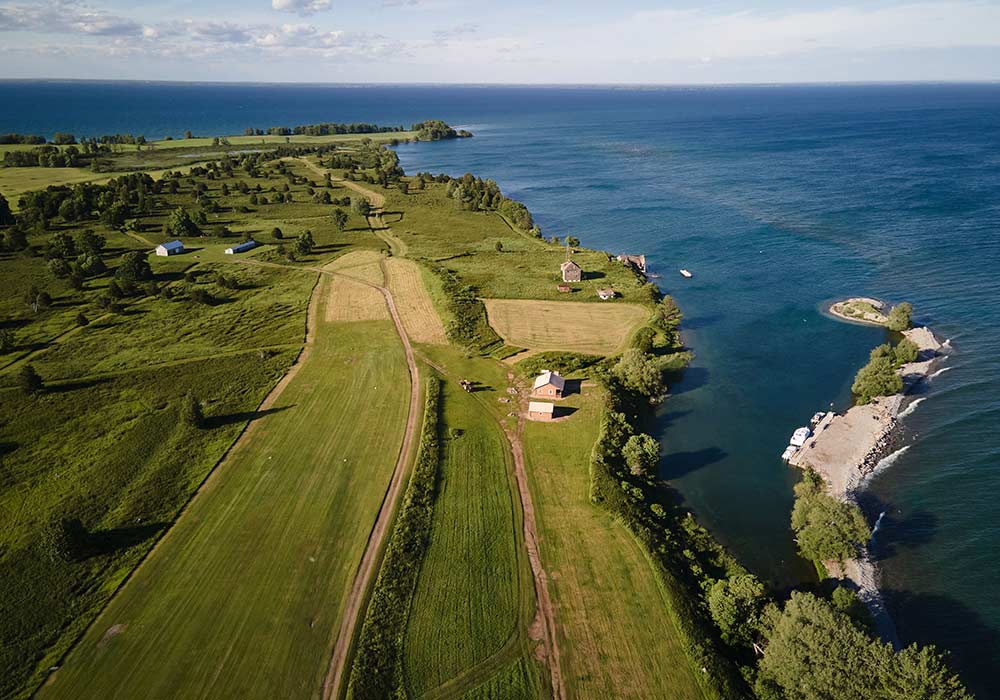News

Coming Home to Galloo
The moment this Great Lakes isle came to market, Mike and John Patten snapped it up. That’s how much it means to them.
Timothy Lake // The Land Report // Summer 2022
More than two decades had passed since Mike Patten and his son John set foot on Galloo Island. Yet both continually obsessed about their island. Although the nearly 2,000-acre sanctuary sits six miles off New York’s northern shores on Lake Ontario, it was always front and center in their minds.
In the 1980s, Galloo belonged to a Patten family company. As impressive as that may sound, it’s a distinction that can be applied to hundreds of thousands of acres in 40 different states. Patten Realty Corporation was America’s first national land development company. Founded in 1966, it ultimately went public and was listed on the New York Stock Exchange. In 1994, it was renamed as Bluegreen Corporation.
Mike helped his father create that company, and Galloo was a favorite corporate retreat. For the last decade, Mike and John have built Patten Companies, which is headquartered in Naples, Florida. Although their primary focus has been developments in the South and in Texas, with the change in seasons, the native New Englanders migrate north to the Berkshires of Massachusetts and Woodlife Ranch, their 1,100-acre getaway nestled along the banks of the Green River.
Invariably, their conversations drifted back to Galloo. “John never lost track of it. He was always watching what was going on there. And when Vladi Private Islands dropped the price to below $8 million, he told me, ‘Let’s do it.” Mike says.
Three longtime family friends and outdoor enthusiasts – Mike Emmons, Davy Roberts, and Kevin Smith – jumped at the chance to throw in as partners. To everyone’s delight, the partnership took title to the island last fall.
ON LAND. One of the island’s standout features is its diverse array of wildlife. Turkey, pheasant, geese, duck, and birds of prey are a few of the many avian species that call Galloo home. Come September, the island is blanketed in monarch butterflies as they migrate south.
Other critters range from coyote to beaver; the white-tailed deer are exceptional. By June, enormous bucks sport sizeable, velvety horns.
“There is nothing like this in the United States – an island with this kind of deer herd,” Mike says.
Galloo’s whitetails enjoy ample room to forage, feed, and breed. The island is 4.5 miles long and 1.5 miles wide. All told, it encompasses more than three square miles and has 11 miles of shoreline.
Thanks to Mother Nature, the herd’s natural feeding grounds are lush and plentiful. Yet supplemental feeding is a necessity. If Northern New York’s notoriously harsh winter weather isn’t enough of a challenge, consider the effects of the subzero gusts that scream off the lake during the dark days of wintertime.
AT SEA. The waters of Lake Ontario are similarly bountiful. “It’s the best smallmouth bass fishing in America,” Mike says. The story of this unusual occurrence deserves to be shared.
Decades ago, when Mike and John Patten first wet a hook in the waters off Galloo, a typical smallmouth bass weighed two or three pounds. Today, four- and five-pounders are routine, and six- and seven-pounders are regularly reeled in.
Credit an odd little fish called the round goby for this upgrade. In the early 1990s, this bottom feeder hitched a ride across the Atlantic in the ballast water of transoceanic ships departing the Black and Caspian Seas of Eastern Europe. Not only did the round goby thrive in all five of the Great Lakes, it flourished. In some areas, it archived densities of 100 fish per square meter. Of equal importance is that Galloo’s rocky and sandy shores are the goby’s preferred feeding grounds, a fact much appreciated by native smallmouth bass. “Ontario’s most unwanted invasive species is our favorite,” Mike says.
Click here to read the full article.

0 Comments